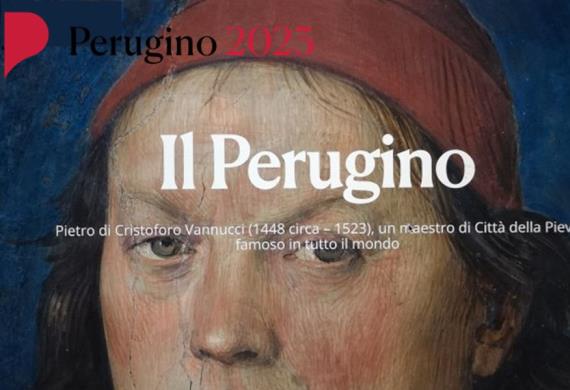IL PERUGINO 2023
(4 MARCH-11 JUNE 2023)
2023 IS THE YEAR OF PERUGINO:
AT THE NATIONAL GALLERY OF UMBRIA OVER 70 WORKS ON SHOW
Perugino
Pietro di Cristoforo Vannucci (c. 1448 – 1523), a world-famous master from Città della Pieve
PERUGIA – “The best master of Italy”. Perugino nel suo tempo”, the exhibition curated by Marco Pierini, director of the National Gallery of Umbria, and Veruska Picchiarelli, curator of the Perugia museum, is the key event of the celebrations for the 500th anniversary of the death of Pietro Vannucci (1450 ca .-1523), called Perugino, coordinated by a National Committee, set up by the Ministry of Culture and chaired by Ilaria Borletti Buitoni.
Hosted at the Galleria Nazionale dell’Umbria in Perugia from 4 March to 11 June 2023, the exhibition consists of over seventy works, from some of the most important national and international museums, such as the Uffizi Galleries, the National Gallery in Washington , the National Gallery in London, the Louvre in Paris and the Gemäldegalerie in Berlin.
Perugino “The best master of Italy”
In a letter dated November 7, 1500, Agostino Chigi, who was among the greatest patrons of his time, defined Perugino as “the best master in Italy”.
The exhibition
The selection includes paintings by Vannucci prior to 1504, the year in which he worked on three commissions that mark the high point of his career: the Crucifixion in the Chigi Chapel in Sant’Agostino in Siena, the Struggle between Love and Chastity already in Mantua, now in the Louvre in Paris, and above all the Marriage of the Virgin for the chapel of the Holy Ring of the Cathedral of Perugia, today in the Musée des Beaux-Arts in Caen (France).
The exhibition project intends to account for the fundamental passages of Perugino’s journey: from the first collaborations in the workshop of Andrea del Verrocchio to the capital Florentine companies that made his fortune (such as, for example, the three panels formerly in San Giusto alle Mura, today in the Gallerie degli Uffizi, or the Altarpiece of San Domenico in Fiesole); from extraordinary portraits to monumental altarpieces, such as the Galitzin Triptych, now in the National Gallery in Washington, and the Polyptych of the Certosa di Pavia, mostly in the National Gallery in London and exceptionally recomposed for the occasion.
The exhibition also reflects on the role that Vannucci actually played in the contemporary art scene in the relationship that linked him to the protagonists of that era, geographically following the movements of the painter or of his works through Italy.
The places where he left indelible traces
Perugino has left deep traces of his mastery in all the localities of the peninsula touched by his activity, from north to south, obviously starting from Umbria and Tuscany, theaters par excellence of his work, as well as headquarters of his workshops in Perugia and Florence.
The fundamental decorative enterprise of the Sistine Chapel, for example, is at the basis of an Umbrian-Lazio trend of “Peruginism”, which finds sublime interpreters in characters such as Antoniazzo Romano, or Antonio da Viterbo known as il Pastura. The impression aroused by the frescoes with Stories of Christ and Stories of Moses in architects of profoundly distant geographical and cultural origins, who approach them on journeys of updating and assimilate them as fundamental study texts, generates very singular phenomena, such as that witnessed by the painting Macrino d’Alba, popularizer of the Perugian style in his native Piedmont. Just as, in the same region, the study of capital trials by Perugino seen between Florence and Pavia is reflected with surprising results in the production of Gaudenzio Ferrari.
The presence of works by the Umbrian master in Romagna and in Emilia, from Fano, to Senigallia, to Bologna is at the basis of the painting of Francesco Francia, Lorenzo Costa and Rimpatta.
A Lombard-Venetian vein of the Perugian vague, witnessed in particular by the works of Tommaso Aleni and Francesco Verla, is linked to the Madonna and Child between Saints Augustine and John the Evangelist in the church of Sant’Agostino in Cremona.
Finally, the great Assumption of the Cathedral of San Gennaro gave further driving force to the diffusion of Peter’s lexicon not only in the Neapolitan area, with the activity of Stefano Sparano or Cristoforo Faffeo, but also in other areas of southern Italy.
To accompany the exhibition, a catalog with the contributions of the major specialists of the painter. Ample margin will be reserved for the directors and curators of the collections to which the works on loan belong.
“The events scheduled for the five hundredth anniversary of his death, and the eagerly awaited exhibition: “The best Master of Italy”, as the banker Agostino Chigi rightly defined him – says Andrea Romizi, mayor of Perugia – are destined to remain in the history and to write a new chapter in the cultural vitality of Perugia, Umbria and our country. Perugino is not only the painter of the sweet angelic Madonnas or of the flowery altarpieces like fragments of heaven on earth, but the very identity of the Umbrian culture spread throughout the world”.
How to visit Perugino’s exhibition at the National Gallery of Umbria?🖌🖼
Here’s some useful info ⬇️
▪️ Where is it:
Corso Pietro Vannucci 19, Perugia.
▪️ Opening hours:
From Monday to Sunday: from 8:30 to 19:30.
The ticket office closes at 6.30pm.
▪️Tickets:
Full price: €10 (valid for access to the exhibition and the rest of the museum)
Verifiable reductions on the official GNU site
▪️ RESERVATION REQUIRED FOR ALL visitors on the occasion of free Sundays (first Sunday of the month) at a cost of € 2.
▪️ For safety reasons, on the free Sundays (first Sunday of the month) it is not possible to make guided tours or group reservations.
▪️ Ticket office and bookshop / reservations:
Email: gnu@sistemamuseo.it
Telephone: +39 075 5721009
Museum system

